|
Oregon California & Eastern Railroad History Page 3- Enter Weyerhaeuser, 1975-1985 |
|
|
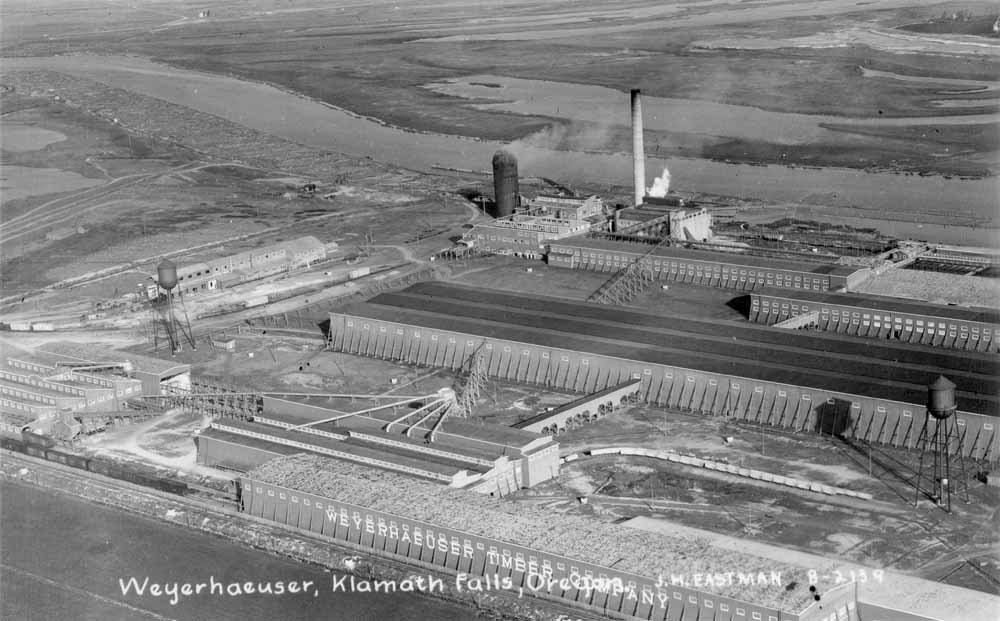 |
|
A postcard view of most of Weyerhaeuser's massive Klamath Falls mill. Jeff Moore collection.
|
|
All of the logging railroads built off of the OC&E were gone by 1948 save for one. Lumber giant
Weyerhaeuser Timber Company had started acquiring timber in the area around Klamath Falls by 1904, and
the company's holdings by 1905 amounted to 158,000 acres, with more being added as it became available.
Weyerhaeuser was not in a big hurry to commence operations until it had two railroads to compete for its
business, and as such construction of the mammoth mill located a few miles south of downtown Klamath Falls
did not get underway until 1928, right after it became apparent that the Great Northern would finally
complete its long-sought line into the city from the north. Weyerhaeuser's plans immediately encoutered stiff opposition from both elements within the community and most of the other sawmills operating in the Klamath area. The late 1910s and early 1920s had been boom times for especially the pine lumber industry as demand had consistently outpaced supply, resulting in ever higher lumber prices. Unfortunately this prompted a lot of new operations to enter the industry and caused existing operations to increase production, and the pine lumber market softened and then cratered right as much of this new production capacity came on line. Most producers in the market attempted to compensate for lower proces with further increased production, which only saturated the market more and further drove prices down. The last thing the industry needed was yet another giant sawmill, and some in the industry and community voiced opinions that Weyerhaeuser ought to sell its timber to existing operators, while others tried to convince the company to buy one of the existing sawmills instead of building a new one. Weyerhaeuser was determined to build its own plant, and when the sawmill went on-line in December 1929 it had a capacity greater than the next four biggest mills in the Klamath basin combined. Construction of the logging railroad that would supply the mill got underway in the summer of 1928. The first operation went westward into the Cascade range, with the end of the logging railroad eventually reaching clear into Jackson County. The first logs were delivered to the sawmill site on 4 February 1929, ten months before the sawmill would saw its first log. The "West Block" railroad provided the bulk of the logs processed by the mill into the 1940s. The railroad continued to run until 1956, when the remaining timber to the west was deemed to be insufficient to support the continued operation of the logging railroad. The railroad was thus abandoned, with many of the grades turned into truck roads. |
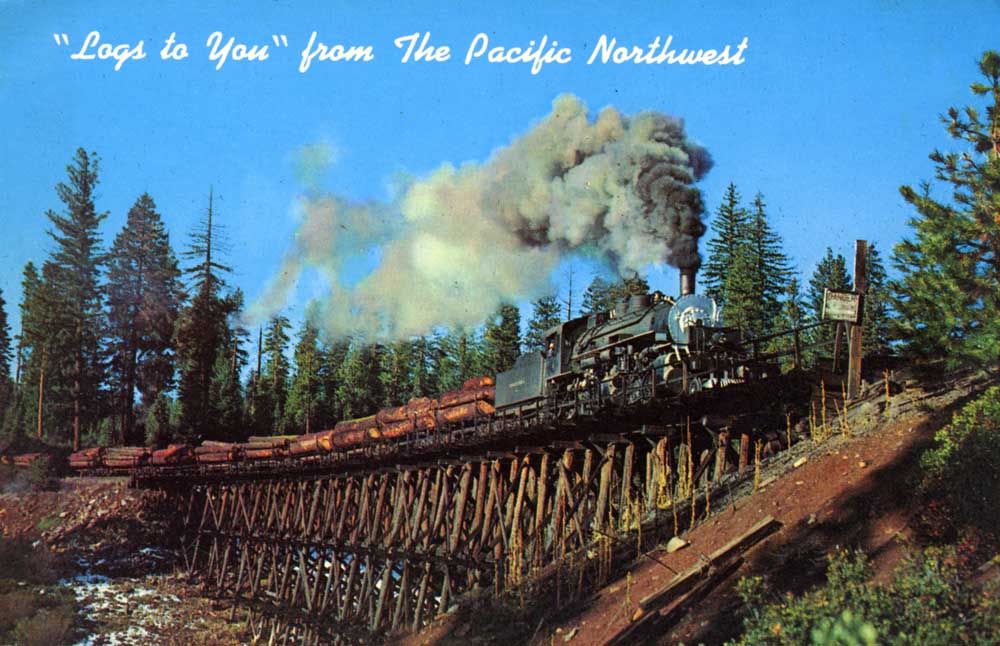 |
|
A commonly produced postcard featuring Weyerhaeuser Timber #4 on one of the large trestles on the West Block railroad.
|
|
In addition to the "west block" of timber that fed the mill's appetite for the first decade of operation,
Weyerhaeuser also held a huge "east block" of timber centered 60 miles northeast of Klamath Falls.
The OC&E provided the best access to this block, but at first quoted Weyerhaeuser what it considered
to be an unreasonably high rate to haul logs into Klamath Falls. Weyerhaeuser started running surveys
for its own railroad from Klamath Falls east into the block, but scrapped those plans after the OC&E
offered a more reasonable rate in 1939. Work on the railroad that would tap the east side block started
north from a connection with OC&E near Beatty in 1940. The OC&E had fallen on hard times by this
point, and Weyerhaeuser gave the road a new lease on life. Construction on the logging railroad, known as the Woods Railroad, headed northward, with the northernmost point (500 Transfer), some 45 miles from Beatty, reached in 1958. Weyerhaeuser built several branches off of this line to various camps through the years. The company also built a shop building at Sycan, about a half mile north of Beatty, to repair the logging and railroad equipment used in the east side block, and an interchange yard was also built at this point. Within a short time period Weyerhaeuser became the only large shipper left on the OC&E. Besides the logging railroad Weyerhaeuser also loaded logs at Bly and, after 1970, purchased and modernized a sawmill in Bly, further increasing the timber giant's reliance on the OC&E. |
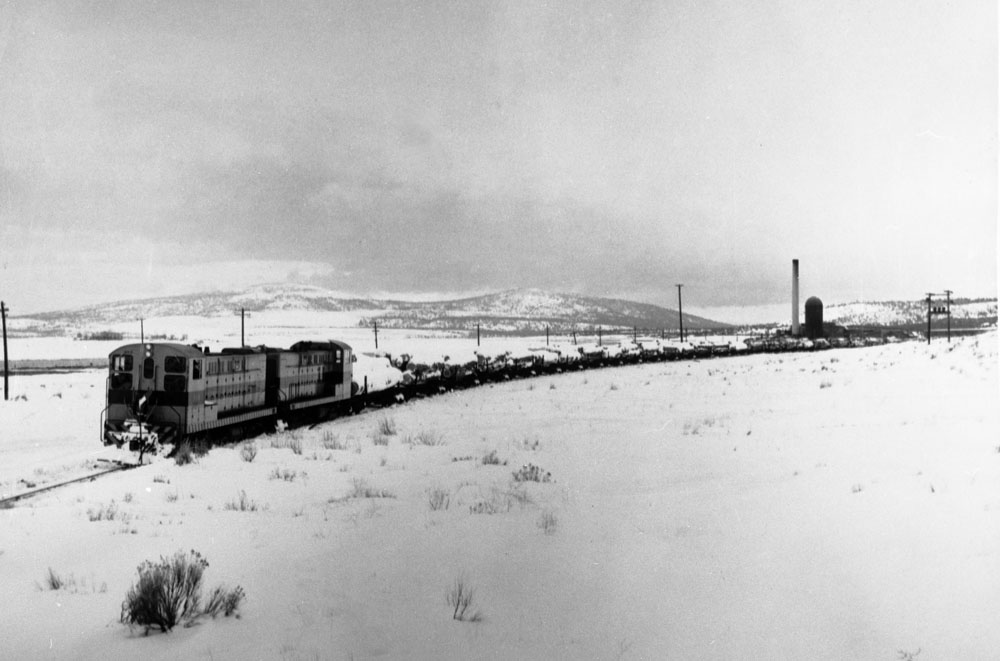 |
|
A pair of Weyerhaeuser's Baldwin switchers with a train of logs in Klamath Falls. Weyerhaeuser photo, John T. Labbe Collection of
Logging and Railroad Photographs, 1892-2010, Washington State Archives, Digital Archives, http://www.digitalarchives.wa.gov.
|
|
Operations on the east side block saw many changes through the 50 years that it operated. Spur line logging
(the practice of building railroads to the harvest sites) was gradually phased out, replaced by trucks
bringing logs from the harvest sites to various reloads established along the railroad. The last of
the spur lines were finally replaced in 1961. Diesels came to the railroad in the form of four switchers
purchased from Baldwin in 1950 and 1951, almost completely replacing steam. The last use of a steam
locomotive came on 7 April 1960, when one was fired up to fill in for an ailing diesel. Weyerhaeuser had been an early convert to the practice of sustained yield forestry, and for the first 45 years of operations at Klamath Falls the company had practiced selective cutting on its lands, leaving un-even aged stands. However, by the mid-1970s economics and changed views within the timber industry caused Weyerhaeuser to re-evaluate its management, and a decision was made to transition the forests away from selective cutting. The company opted to instead start practicing even-age management, which meant periodic clear cutting of stands followed by intensified management to promote high growth and restocking rates. To transition the forests to the new way of doing things much of the existing forests had to be clear-cut to make way for the planned even-age stands. Weyerhaeuser concluded that it would now need to use its private railroad and the OC&E at a much higher rate than before in order to get this glut of timber out. |
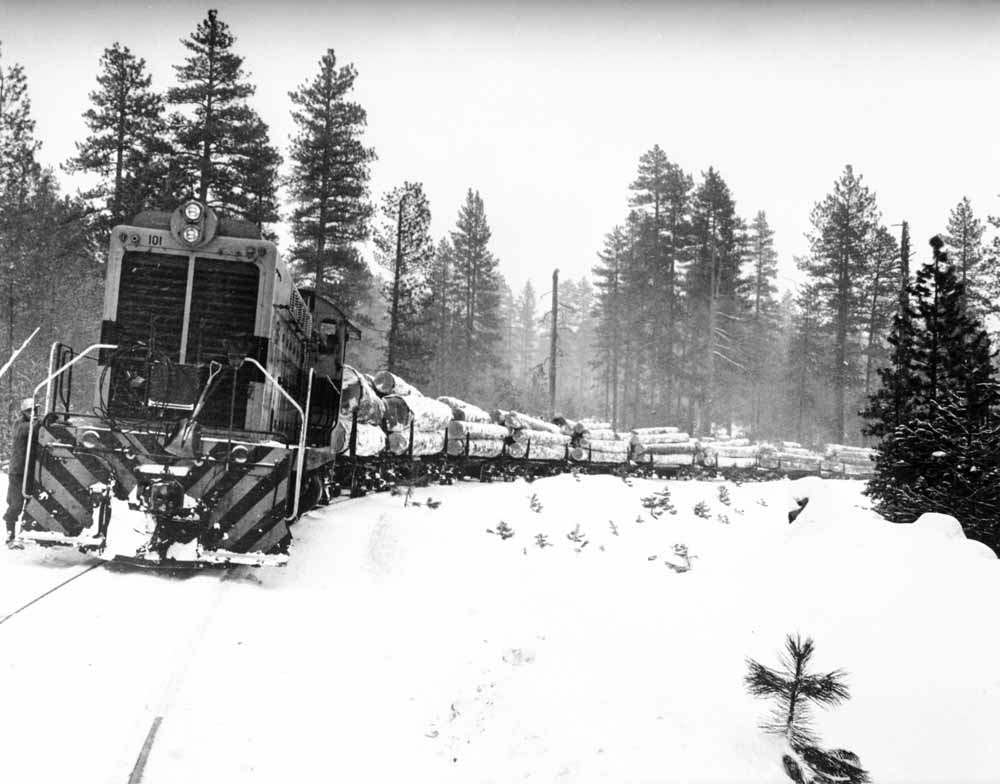 |
|
Weyerhaeuser #101 with the last train of logs loaded by a McGiffert loader. Weyerhaeuser photo, John T. Labbe Collection of
Logging and Railroad Photographs, 1892-2010, Washington State Archives, Digital Archives, http://www.digitalarchives.wa.gov.
|
|
Weyerhaeuser quickly ran into problems with the transportation end of its plans. The OC&E had long
been a neglected stepchild of both of its corporate parents, and the physical plant was nowhere near
capable of holding up under the rapid increase in carloadings. Log shipments over the OC&E had
averaged 8,000 a year through the 1960s, but by 1970 this total was up to 18,000, including shipments
of finished products from the Bly mill. Neither Burlington Northern (successor company to Great Northern)
or Southern Pacific were willing to put money into the railroad to rehabilitate it, especially for the one
shipper that remained. The obvious solution was for Weyerhaeuser to buy the OC&E, and negotiations to
do so started in 1974. The deal to buy the OC&E was worked out in due time, and Weyerhaeuser took possession of the OC&E on 1 January 1975. Total purchase price was $2.38 million. What Weyerhaeuser got for its money was the entire railroad, four cabooses, two fire service tank cars, five flat cars, and some other miscellaneous pieces of rolling stock. The first order of business on the new railroad was rehabilitation. The roadbed and track structure were in terrible shape, as maintenance had not been a high priority under the previous joint SP-GN ownership. Weyerhaeuser spent a grand total of $7.8 million dollars over the next seven years to rehabilitate the railroad, including replacing between 6,000 and 8,000 ties per year and dumping a lot of ballast. A tamper and some other track equipment was purchased to assist with the trackwork. Weyerhaeuser's fleet of wooden log cars was also wearing out and had to be replaced, and as a solution the OC&E purchased large numbers of steel flatcars that were equipped with log bunks and placed into service. The railroad also bought numerous boxcars, gondolas, and other types of freight cars, removed the bodies, and produced acceptable log cars from the remaining frames. |
|
|
|
Weyerhaeuser Timber Company Camp 15. Jerry Lamper photo, used with permission.
|
|
Five Alco road switchers were purchased from the Southern Pacific at the start-up of operations, but none
of them ran on arrival, and the Sycan shops were not able to make the units run properly despite spending
a small fortune in repairs. Four of the units were turned back to the SP, while the fifth destroyed itself
in a fire and was scrapped. Weyerhaeuser then leased power from various sources, including the Southern
Pacific, Burlington Northern and Union Pacific until mid-1976, when seven re-manufactured locomotives
arrived from Morrison-Knudson. All seven were re-built from ex-Union Pacific General Electric-built U25B
type locomotives. Five of the seven were re-powered with Electro-Motive Division of General Motors-built
model 567 prime movers, while the other two were stripped down and made into slug units (locomotives that
have no prime movers in them, instead relying on power provided by connecting units to run their traction
motors). The OC&E at the time was handling around 100 carloads of logs per day from Sycan, which had
to be taken down to Klamath Falls in two cuts of 45 cars each, as that was the limit on train length
imposed by the length of the switchback tail tracks at Bly Mountain. Normal operational patterns saw
two locomotive/slug/locomotive sets operating on the railroad, with the fifth unit cycled through the
shop for required inspections and repairs. Any trains approaching the switchbacks that were longer than
45 cars had to reduce their train size, which resulted in many extra trains ran from Klamath Falls to
Sprague River to collect log loads set out by excess-length trains. Operations in the first years of Weyerhaeuser ownership saw as many as seven different jobs called each day, consisting of three or four road jobs and up to three yard jobs. The railroad only got busier, with the peak of over 35,000 loads per year handled in 1978-1979, including around 4,000 loads of lumber and woodchips from the Bly mill. Four additional Baldwin road switcher-type locomotives were purchased to help handle the massive amount of traffic that the railroad was generating at the time. However, carloadings went into a steep decline after that, with 14,276 loads handled in 1982, almost all logs as the Bly mill closed. At this point Weyerhaeuser finally decided to do something about the switchbacks that limited train lengths over Bly mountain. After considering various possibilities, the solution decided upon was to lay a second tail track at each switchback, meaning that the railroad could now handle up to 90 cars on each train, which meant that one single road job could bring all logs from Sycan and Bly to Klamath Falls in one train instead of the two or three required before the second tail tracks were added. The early 1980s also saw the demise of the Baldwin switchers that had been powering the woods line for over thirty years. Replacement power came in the form of two EMD GP-9 type locomotives purchased from the Burlington Northern, and for a while the new arrivals were mated with the OC&E's Baldwin road switchers. However, by the spring of 1984 the GP-9s had been re-wired so that they would run with the OC&E slugs. Typical motive power assignments saw the Woods Railroad running with two GP-9s and two slugs, while the standard power on the OC&E was a quartet of the M-K rebuilds. A third ex-BN GP-9 and another M-K rebuild moved in from another operation filled out the motive power fleet at this time. |
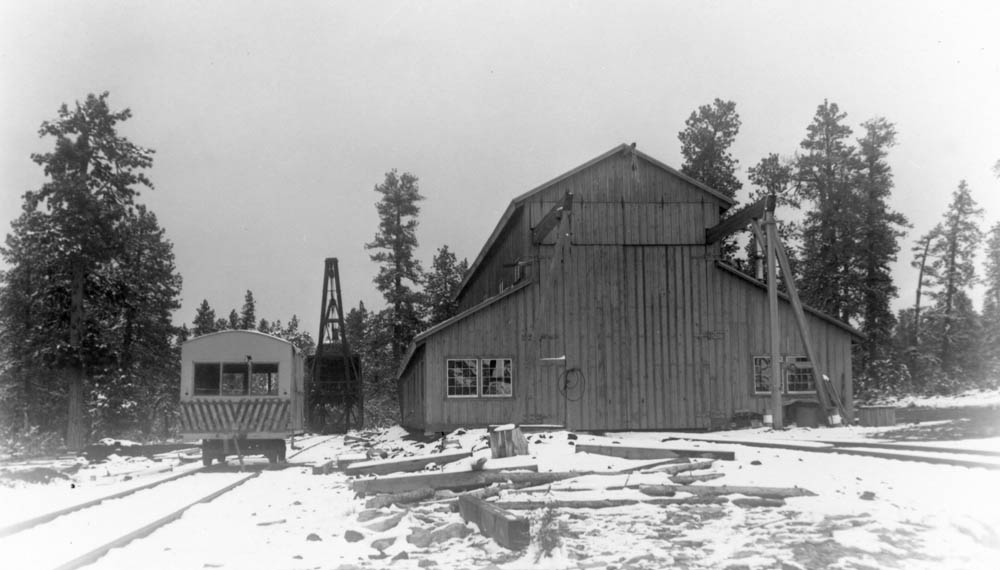 |
|
A shop building at one of the Weyerhaeuser camps in the East Block. Jerry Lamper photo, used with permission. |
|
|
|
|